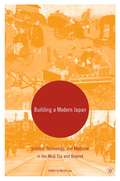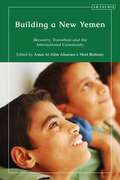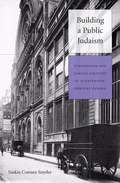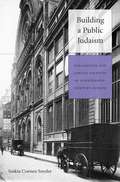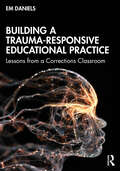- Table View
- List View
Building a Compact City: Spatial Planning in Yinchuan City, Western China (SpringerBriefs in Geography)
by Meng WangThis book serves as a solid ground for seeking strategies to build the compact city that situated in a specific local area, based on the systematic examination of the effects of spatial planning system on urbanization control. Furthermore, the critical problems in the urban planning process are revealed, and the possible approaches to improve the local planning system toward effectively promoting more compact development are discussed. This book also provides a comprehensive picture for understanding the mutual influences between the planning, its implementation, and urban developments, particularly in the context of cities of western China, while these cities are experiencing dramatic urban growth in recent years but walking into a quite different development path comparing to the eastern mega cities. In nearly two decades, government officials, professional planners, scholars of urban studies, citizens who concern sustainable development are talking about the compact city, a promising vision for sustaining our growing or shrinking cities. Abundance of debates fall on the images, measurement and strengths of the compact city, while the substantializing of the vision in a specific city has been barely explored.
Building a Culture of Lawfulness: An Interdisciplinary Approach to the Rule of Law
by Heath B. GrantThis book is the first interdisciplinary study of the rule of law in an environment of complementary culture. It argues that the rule of law should not be defined solely through the development of institutions, but also through the mobilization of existing culture towards support for law and its enforcement. Recognizing that the rule of law is most often misunderstood by many, the book describes the benefits of the rule of law and exposes its weaknesses and limitations. It summarizes the history and practice through case studies where culture has played an essential role in achieving a sustainable rule of law in practice. It incorporates the unique challenges to rule of law in regions like the Middle East, and addresses the nexus of law culture and institutions in the context of policing in the United States. Appropriate for researchers, professionals, and practitioners of law, policing, cultural criminology, and sociology, this book identifies practical and actionable elements of culture that can be mobilized, even in states that are only in the initial stages of developing the rule of law.
Building a Cybersecurity Culture in Organizations: How to Bridge the Gap Between People and Digital Technology (Studies in Systems, Decision and Control #284)
by Isabella CorradiniThis book offers a practice-oriented guide to developing an effective cybersecurity culture in organizations. It provides a psychosocial perspective on common cyberthreats affecting organizations, and presents practical solutions for leveraging employees’ attitudes and behaviours in order to improve security.Cybersecurity, as well as the solutions used to achieve it, has largely been associated with technologies. In contrast, this book argues that cybersecurity begins with improving the connections between people and digital technologies. By presenting a comprehensive analysis of the current cybersecurity landscape, the author discusses, based on literature and her personal experience, human weaknesses in relation to security and the advantages of pursuing a holistic approach to cybersecurity, and suggests how to develop cybersecurity culture in practice. Organizations can improve their cyber resilience by adequately training their staff. Accordingly, the book also describes a set of training methods and tools. Further, ongoing education programmes and effective communication within organizations are considered, showing that they can become key drivers for successful cybersecurity awareness initiatives. When properly trained and actively involved, human beings can become the true first line of defence for every organization.
Building a Future on Peace and Justice: Studies on Transitional Justice, Peace and Development The Nuremberg Declaration on Peace and Justice
by Kai Ambos Judith Large Marieke WierdaResults of the 2007 Nuremberg Conference on Peace and Justice: Tensions between peace and justice have long been debated by scholars, practitioners and agencies including the United Nations, and both theory and policy must be refined for very practical application in situations emerging from violent conflict or political repression. Specific contexts demand concrete decisions and approaches aimed at redress of grievance and creation of conditions of social justice for a non-violent future. There has been definitive progress in a world in which blanket amnesties were granted at times with little hesitation. There is a growing understanding that accountability has pragmatic as well as principled arguments in its favour. Practical arguments as much as shifts in the norms have created a situation in which the choice is increasingly seen as "which forms of accountability" rather than a stark choice between peace and justice. It is socio-political transformation, not just an end to violence, that is needed to build sustainable peace. This book addresses these dilemmas through a thorough overview of the current state of legal obligations; discussion of the need for a holistic approach including development; analysis of the implications of the coming into force of the ICC; and a series of "hard" case studies on internationalized and local approaches devised to navigate the tensions between peace and justice.
Building a Just and Secure World: Popular Front Women's Struggle for Peace and Justice in Chicago During the 1960s
by Amy C. SchneidhorstBuilding a Just and Secure World highlights women's activism, often peripheral and one-dimensional in peace movement historiography which tends to dramatize men's antiwar and antinuclear activism in national organizations. In Chicago, an urban center of anti-war and civil rights activism, a generation of middle-aged women leaders came to their involvement in the movement through previous experience in mixed-sex Leftist movements and local civil rights campaigns. Participant historians of Sixties New Left, peace, and feminist movements of the Sixties have argued that the Old Left was defunct and the younger generation re-energized socialism in the early 1960s. These historians characterized Popular Front leftists as anticommunist cold war liberals who had abandoned youthful revolutionary aspirations for the reformist New Deal welfare state. Contrary to the arguments the Popular Front politics were defunct, Schneidhorst joins historians who argue the Popular Front generation continued to promote progressive and radical goals into the 1960s.
Building a Just and Secure World: Popular Front Women's Struggle for Peace and Justice in Chicago During the 1960s
by Amy C. SchneidhorstBuilding a Just and Secure World highlights women's activism, often peripheral and one-dimensional in peace movement historiography which tends to dramatize men's antiwar and antinuclear activism in national organizations. In Chicago, an urban center of anti-war and civil rights activism, a generation of middle-aged women leaders came to their involvement in the movement through previous experience in mixed-sex Leftist movements and local civil rights campaigns. Participant historians of Sixties New Left, peace, and feminist movements of the Sixties have argued that the Old Left was defunct and the younger generation re-energized socialism in the early 1960s. These historians characterized Popular Front leftists as anticommunist cold war liberals who had abandoned youthful revolutionary aspirations for the reformist New Deal welfare state. Contrary to the arguments the Popular Front politics were defunct, Schneidhorst joins historians who argue the Popular Front generation continued to promote progressive and radical goals into the 1960s.
Building a Modern Japan: Science, Technology, and Medicine in the Meiji Era and Beyond
by M. LowIn the late Nineteenth-century, the Japanese embarked on a program of westernization in the hope of building a strong and modern nation. Science, technology and medicine played an important part, showing European nations that Japan was a world power worthy of respect. It has been acknowledged that state policy was important in the development of industries but how well-organized was the state and how close were government-business relations? The book seeks to answer these questions and others. The first part deals with the role of science and medicine in creating a healthy nation. The second part of the book is devoted to examining the role of technology, and business-state relations in building a modern nation.
Building a New Biocultural Synthesis: Political-Economic Perspectives on Human Biology (Linking Levels Of Analysis)
by Alan H. Goodman Thomas Leland LeathermanAnthropology, with its dual emphasis on biology and culture, is--or should be--the discipline most suited to the study of the complex interactions between these aspects of our lives. Unfortunately, since the early decades of this century, biological and cultural anthropology have grown distinct, and a holistic vision of anthropology has suffered. This book brings culture and biology back together in new and refreshing ways. Directly addressing earlier criticisms of biological anthropology, Building a New Biocultural Synthesis concerns how culture and political economy affect human biology--e.g., people's nutritional status, the spread of disease, exposure to pollution--and how biological consequences might then have further effects on cultural, social, and economic systems. Contributors to the volume offer case studies on health, nutrition, and violence among prehistoric and historical peoples in the Americas; theoretical chapters on nonracial approaches to human variation and the development of critical, humanistic and political ecological approaches in biocultural anthropology; and explorations of biological conditions in contemporary societies in relationship to global changes. Building a New Biocultural Synthesis will sharpen and enrich the relevance of anthropology for understanding a wide variety of struggles to cope with and combat persistent human suffering. It should appeal to all anthropologists and be of interest to sister disciplines such as nutrition and sociology. Alan H. Goodman is Professor of Anthropology, Hampshire College. Thomas L. Leatherman is Associate Professor of Anthropology, University of South Carolina.
Building a New Community Psychology of Mental Health: Spaces, Places, People and Activities
by Carl Walker Angie Hart Paul HannaThis book provides a much-needed account of informal community-based approaches to working with mental distress. It starts from the premise that contemporary mainstream psychiatry and psychology struggle to capture how distress results from complex embodied arrays of social experiences that are embedded within specific historical, cultural, political and economic settings. The authors challenge mainstream understandings of mental health that position a naive public in need of mental health literacy. Instead it is clear that a considerable amount of invaluable mental distress work is undertaken in spaces in our communities that are not understood as mental health treatments. This book represents one of the first attempts to position these kinds of spaces at the center of how we understand and address problems of mental distress and suffering. The chapters draw on case studies from the UK and abroad to point toward an exciting new paradigm based on informal community and socially oriented approaches to mental health. Written in an unusually accessible and engaging style, this book will appeal to social science students, academics, practitioners and policy makers interested in community and social approaches to mental health.
Building a New World: Luce Irigaray: Teaching Ii (Palgrave Studies in Postmetaphysical Thought)
by Luce Irigaray Michael MarderWith an original introduction by Luce Irigaray, and original texts from her students and collaborators, this book imagines the outlines of a more just, ecologically attuned world that flourishes on the basis of sexuate difference.
Building a New Yemen: Recovery, Transition and the International Community
by Amat Al Alim Alsoswa and Noel BrehonyYemen has faced continuing crises since 2010. The fighting and divisions have destroyed much of Yemen's physical, political and social infrastructure, undermining its tribal traditions and religious tolerance, and impoverishing the country. The outbreak of war in 2015 caused the world's worst humanitarian crisis. In this book, Yemeni and international experts assess what political arrangements are required to overcome fragmentation and discord in Yemen. They look to understand how people from all parts of the county can work together to build a new Yemen, one that will give a voice to its young population and provide a full role for women. The contributors argue that Yemen's major resource is its population, but that Yemenis need to be motivated and trained to give them the skills to rebuild the economy and to prepare for long-term challenges such as water shortages and climate change. The volume also discusses how the international community will need to absorb the lessons of the past to find better ways of creating the institutions, mechanisms and transparency with Yemenis that will enable the flow of vital assistance to where it is most needed.The book provides an up-to-date analysis to help governments and international agencies who will have to work with Yemen and its neighbours in the post conflict situation.
Building a New Yemen: Recovery, Transition and the International Community
Yemen has faced continuing crises since 2010. The fighting and divisions have destroyed much of Yemen's physical, political and social infrastructure, undermining its tribal traditions and religious tolerance, and impoverishing the country. The outbreak of war in 2015 caused the world's worst humanitarian crisis. In this book, Yemeni and international experts assess what political arrangements are required to overcome fragmentation and discord in Yemen. They look to understand how people from all parts of the county can work together to build a new Yemen, one that will give a voice to its young population and provide a full role for women. The contributors argue that Yemen's major resource is its population, but that Yemenis need to be motivated and trained to give them the skills to rebuild the economy and to prepare for long-term challenges such as water shortages and climate change. The volume also discusses how the international community will need to absorb the lessons of the past to find better ways of creating the institutions, mechanisms and transparency with Yemenis that will enable the flow of vital assistance to where it is most needed.The book provides an up-to-date analysis to help governments and international agencies who will have to work with Yemen and its neighbours in the post conflict situation.
Building a Prosperous Southeast Asia: Moving from Ersatz to Echt Capitalism
by Kunio YoshiharaProfessor Yoshihara, an international expert on the Southeast Asian economies, looks beyond the causes of the current crisis to discuss what can be done to build a dynamic economy in Asia to ensure prosperity for the future. He takes the viewpoint that the only way to achieve this is to promote integration into the global economy through free trade and free capital movement. He puts forward a convincing argument that government intervention is not the way forward and has in fact helped cause the present crisis. But a prosperous future is possible, he argues, by renovating institutions and adapting new attitudes. A most timely book with lessons for other parts of the world as well as for Southeast Asia.
Building a Prosperous Southeast Asia: Moving from Ersatz to Echt Capitalism
by Kunio YoshiharaProfessor Yoshihara, an international expert on the Southeast Asian economies, looks beyond the causes of the current crisis to discuss what can be done to build a dynamic economy in Asia to ensure prosperity for the future. He takes the viewpoint that the only way to achieve this is to promote integration into the global economy through free trade and free capital movement. He puts forward a convincing argument that government intervention is not the way forward and has in fact helped cause the present crisis. But a prosperous future is possible, he argues, by renovating institutions and adapting new attitudes. A most timely book with lessons for other parts of the world as well as for Southeast Asia.
Building a Public Judaism: Synagogues And Jewish Identity In Nineteenth-century Europe
by Saskia Coenen SnyderCoenen Snyder considers what the architecture and construction of nineteenth-century European synagogues reveal about the social progress of modern European Jews. The process of claiming a Jewish space was a marker of acculturation but not full acceptance, she argues. The new edifices, even if spectacular, revealed the limits of Jewish integration.
Building a Public Judaism: Synagogues And Jewish Identity In Nineteenth-century Europe
by Saskia Coenen SnyderCoenen Snyder considers what the architecture and construction of nineteenth-century European synagogues reveal about the social progress of modern European Jews. The process of claiming a Jewish space was a marker of acculturation but not full acceptance, she argues. The new edifices, even if spectacular, revealed the limits of Jewish integration.
Building a Resilient Twenty-First-Century Economy for Rural America
by Don E. AlbrechtIn Building a Resilient Twenty-First-Century Economy for Rural America, Don E. Albrecht visits rural communities that have traditionally been dependent on a variety of goods-producing industries, explores what has happened as employment in these industries has declined, and provides a path by which they can build a vibrant twenty-first-century economy. Albrecht describes how structural economic changes led rural voters to support Donald Trump in the 2016 election and why his policies will not relieve the economic problems of rural residents. Trump’s promises to restore rural industrial jobs simply cannot be fulfilled because his policies do not address the base cause for this job loss—technological change, the most significant factor being the machine replacement of human labor in the production process. Bringing a personal understanding of the effects on rural communities and residents, Albrecht focuses each chapter on a community that has traditionally been economically dependent on a single industry—manufacturing, coal mining, agriculture, logging, oil and gas production, and tourism—and the consequences of losing that industry. He also lays out a plan for rebuilding America’s rural areas and creating an economically vibrant country with a more sustainable future. The rural economy cannot return to the past as it was structured and instead must look to a new future. Building a Resilient Twenty-First-Century Economy for Rural America describes the source of economic concerns in rural America and offers real ways to address them. It will be vital to students, scholars, practitioners, community leaders, politicians, and policy makers concerned with rural community development.
Building a traditional Kurdish City: The Urban Morphology of Sanandaj
by Hooshmand AlizadehThis book will fill an important gap in the knowledge of Middle Eastern cities by reconstructing the historical process of Sanandaj's formation and development until the rise of modernization in Iran. It discusses the nature of Kurdish settlements and the interaction between the social and spatial forces that have conditioned the processes and patterns of city formation and development over time. It identifies distinctive aspects of Kurdish settlements, such as their extroverted connection with the landscape, and the fluent interplay between private and public realms in female experience, providing a foundation for further studies of other Kurdish cities in the region. It will be an excellent resource for students and researchers of urban studies, geography, social science, and Kurdish studies.
Building a Trauma-Responsive Educational Practice: Lessons from a Corrections Classroom
by Em DanielsThis timely manual presents a new perspective on teaching and learning focused on countering the impacts of trauma on adults’ ability to learn. Within its detailed and useful approaches, Daniels provides a road map for building a trauma-responsive teaching practice grounded in the principles of Trauma-Informed Care, and emphasizing the need for educators to develop a rigorous practice of self-care. Prison classrooms, in particular, demonstrate the intersectional and overlapping nature of systemic, historical, and individual traumatic experience. People who rediscover themselves as learners while in corrections classrooms have a unique and powerful perspective to bring to the work of ending mass incarceration, and the role of education and learning in that ending. The concepts and framework presented in the text aim to expand how we define "working with trauma." Through this redefinition, we better align teaching and learning as counters to the impacts of trauma. As this alignment transforms educational philosophy and practice, we have an opportunity to repurpose the nature of education itself, and shift toward learning how to learn. Although this book contains content specific to corrections educators, or those aspiring to teach in prisons, its concepts and activities are applicable to any environment or situation in which adults need to learn. Adult educators, front-line personnel in any public service role, librarians, legal professionals, judges, lawyers—all can benefit from the expertise shared in this book.
Building a Trauma-Responsive Educational Practice: Lessons from a Corrections Classroom
by Em DanielsThis timely manual presents a new perspective on teaching and learning focused on countering the impacts of trauma on adults’ ability to learn. Within its detailed and useful approaches, Daniels provides a road map for building a trauma-responsive teaching practice grounded in the principles of Trauma-Informed Care, and emphasizing the need for educators to develop a rigorous practice of self-care. Prison classrooms, in particular, demonstrate the intersectional and overlapping nature of systemic, historical, and individual traumatic experience. People who rediscover themselves as learners while in corrections classrooms have a unique and powerful perspective to bring to the work of ending mass incarceration, and the role of education and learning in that ending. The concepts and framework presented in the text aim to expand how we define "working with trauma." Through this redefinition, we better align teaching and learning as counters to the impacts of trauma. As this alignment transforms educational philosophy and practice, we have an opportunity to repurpose the nature of education itself, and shift toward learning how to learn. Although this book contains content specific to corrections educators, or those aspiring to teach in prisons, its concepts and activities are applicable to any environment or situation in which adults need to learn. Adult educators, front-line personnel in any public service role, librarians, legal professionals, judges, lawyers—all can benefit from the expertise shared in this book.
Building a Travel Risk Management Program: Traveler Safety and Duty of Care for Any Organization
by Charles BrossmanBuilding a Travel Risk Management Program: Traveler Safety and Duty of Care for Any Organization helps business and security professionals effectively manage traveler risk by showing them how to build a complete travel risk program. While global corporate travel risks are increasing exponentially, many security and business managers are not well-versed in the rapidly changing global landscape of travel risk, nor do they fully realize the multitude of risks their companies face if they don’t comply with their legal obligations—“duty of care"—for protecting their employees from foreseeable harm, which can cost a company in the form of extensive fines, productivity loss, business interruptions, stock price loss, litigation, and even potential bankruptcy. This book is the first to bridge the gap between the topics of travel management, security, and risk management. It serves as a reference point for working with other departments, including human resources and legal, paving the way for better internal cooperation for travel managers and security managers. In addition, it helps organizations craft a travel risk management program for their unique needs that incorporates the most important policies and procedures that help them comply with legal obligations.Illustrates common mistakes that can have a devastating impact across the entire enterprise with real-world examples and case studiesIncludes testimonies from corporate travel risk security experts on best practices for meeting the constantly changing duty of care standardPresents best practices for reducing the risk of exposure and liabilityOffers models for effectively promoting and advocating for travel risk management programs within the organizationCompares laws like the UK"s “Corporate Manslaughter Act" (considered one of the world’s most strict legislative standards) to similar laws around the world, showing how compliance requires constant supervision and process improvement
Building a World Heritage City: Sanaa, Yemen (Heritage, Culture and Identity)
by Michele Lamprakos"Society of Architectural Historians Spiro Kostof Book Award, Honorable Mention, 2018" The conservation of old Sanaa is a major cultural heritage initiative that began in the 1980's under the auspices of UNESCO; it continues today, led by local agencies and actors. In contrast to other parts of the world where conservation was introduced at a later date to remediate the effects of modernization, in Yemen the two processes have been more or less concurrent. This has resulted in a paradox: unlike many other countries in the Middle East that abandoned traditional construction practices long ago, in Yemen these practices have not died out. Builders and craftsmen still work in 'traditional' construction, and see themselves as caretakers of the old city. At the same time, social forms that shaped the built fabric persist in both the old city and the new districts. Yemenis, in effect, are not separated from their heritage by an historical divide. What does it mean to conserve in a place where the 'historic past' is, in some sense, still alive? How must international agencies and consultants readjust theory and practice as they interact with living representatives of this historic past? And what are the implications of the case of Sanaa for conservation in general? Building a World Heritage City addresses these questions and also fosters greater cultural understanding of a little known, but geopolitically important, part of the world that is often portrayed exclusively in terms of unrest and political turmoil.
Building a World Heritage City: Sanaa, Yemen (Heritage, Culture and Identity)
by Michele Lamprakos"Society of Architectural Historians Spiro Kostof Book Award, Honorable Mention, 2018" The conservation of old Sanaa is a major cultural heritage initiative that began in the 1980's under the auspices of UNESCO; it continues today, led by local agencies and actors. In contrast to other parts of the world where conservation was introduced at a later date to remediate the effects of modernization, in Yemen the two processes have been more or less concurrent. This has resulted in a paradox: unlike many other countries in the Middle East that abandoned traditional construction practices long ago, in Yemen these practices have not died out. Builders and craftsmen still work in 'traditional' construction, and see themselves as caretakers of the old city. At the same time, social forms that shaped the built fabric persist in both the old city and the new districts. Yemenis, in effect, are not separated from their heritage by an historical divide. What does it mean to conserve in a place where the 'historic past' is, in some sense, still alive? How must international agencies and consultants readjust theory and practice as they interact with living representatives of this historic past? And what are the implications of the case of Sanaa for conservation in general? Building a World Heritage City addresses these questions and also fosters greater cultural understanding of a little known, but geopolitically important, part of the world that is often portrayed exclusively in terms of unrest and political turmoil.
Building Abolition: Decarceration and Social Justice (Routledge Studies in Penal Abolition and Transformative Justice)
by Kelly Struthers MontfordBuilding Abolition: Decarceration and Social Justice explores the intersections of the carceral in projects of oppression, while at the same time providing intellectual, pragmatic, and undetermined paths toward abolition. Prison abolition is at once about the institution of the prison, and a broad, intersectional political project calling for the end of the social structured by settler colonialism, anti-black racism, and related oppressions. Beyond this, prison abolition is a constructive project that imagines and strives for a transformed world in which justice is not equated with punishment, and accountability is not equated with caging. Composed of sixteen chapters by an international team of scholars and activists, with a Foreword by Perry Zurn and an Afterword by Justin Piché, the book is divided into four themes: • Prisons and Racism • Prisons and Settler Colonialism • Anti-Carceral Feminisms • Multispecies Carceralities. This book will be of interest to undergraduate and postgraduate students, activists, and scholars working in the areas of Critical Prison Studies, Critical Criminology, Native Studies, Postcolonial Studies, Black Studies, Critical Race Studies, Gender and Sexuality Studies, and Critical Animal Studies, with particular chapters being of interest to scholars and students in other fields, such as, Feminist Legal Studies, Animal Law, Critical Disability Studies, Queer Theory, and Transnational Feminisms.
Building Abolition: Decarceration and Social Justice (Routledge Studies in Penal Abolition and Transformative Justice)
by Kelly Struthers Montford Chloë TaylorBuilding Abolition: Decarceration and Social Justice explores the intersections of the carceral in projects of oppression, while at the same time providing intellectual, pragmatic, and undetermined paths toward abolition. Prison abolition is at once about the institution of the prison, and a broad, intersectional political project calling for the end of the social structured by settler colonialism, anti-black racism, and related oppressions. Beyond this, prison abolition is a constructive project that imagines and strives for a transformed world in which justice is not equated with punishment, and accountability is not equated with caging. Composed of sixteen chapters by an international team of scholars and activists, with a Foreword by Perry Zurn and an Afterword by Justin Piché, the book is divided into four themes: • Prisons and Racism • Prisons and Settler Colonialism • Anti-Carceral Feminisms • Multispecies Carceralities. This book will be of interest to undergraduate and postgraduate students, activists, and scholars working in the areas of Critical Prison Studies, Critical Criminology, Native Studies, Postcolonial Studies, Black Studies, Critical Race Studies, Gender and Sexuality Studies, and Critical Animal Studies, with particular chapters being of interest to scholars and students in other fields, such as, Feminist Legal Studies, Animal Law, Critical Disability Studies, Queer Theory, and Transnational Feminisms.





